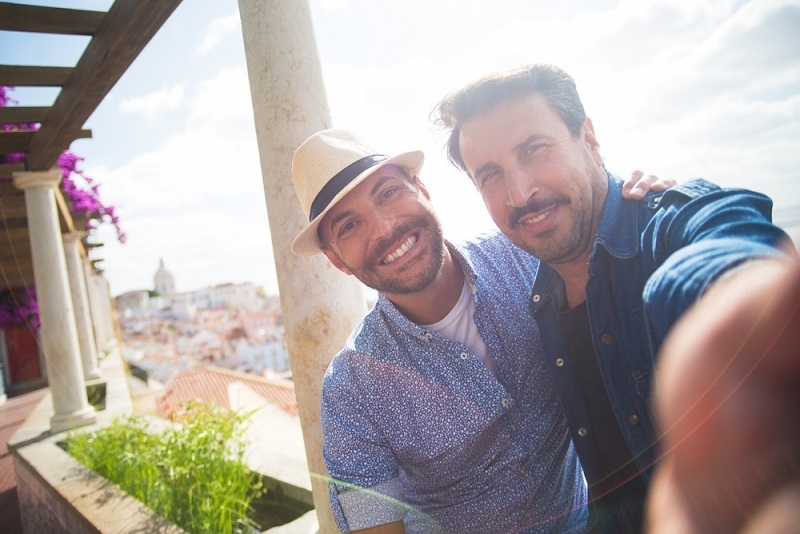Find Your Perfect Match with These Top Gay Dating Apps

Dive into the digital realm of LGBTQ+ dating with our insightful review of the top gay dating apps. From pioneering platforms like Grindr to niche spaces and unexpected social media connections, explore how these apps shape interactions, relationships, and community dynamics within the gay community today. Let's look at the top gay dating apps.
1. The Pioneer: Grindr
The best gay dating apps combine user-friendly interfaces with robust privacy features, ensuring a safe and enjoyable experience. Grindr revolutionized the digital dating landscape when it launched, becoming the first major dating app for gay men. It utilized location-based technology to connect men with potential partners in their vicinity, breaking new ground in accessibility and immediacy in the gay dating scene. Grindr remains a cornerstone in the LGBTQ+ community, celebrated for its pioneering role and enduring relevance.
2. Swiping Right: Tinder's Gay Journey
Originally known for its mainstream appeal, Tinder has made significant strides to be inclusive of the LGBTQ+ community. By allowing users to identify their sexual orientation and tailor who they see in the app, Tinder has become a welcoming platform for gay users seeking both casual and serious relationships.
3. Beyond Grindr: Scruff
Free gay dating apps provide accessible options for those looking to explore the dating scene without a financial commitment. Scruff carved out its niche by catering to a "scruffier" clientele, offering an alternative to Grindr's broader base. It has been a trailblazer in implementing features tailored to the gay community, including travel safety advisories and events, making it more than just a dating app but a social network.
4. A Global Love Affair: Planet Romeo
Good dating apps for gay individuals prioritize inclusivity, allowing users to express themselves fully and find matches who truly understand them. Popular primarily in Europe, Planet Romeo has established itself as a key player in the gay dating scene. It offers a mix of dating, social networking, and health resources, creating a supportive online environment for its users. Its enduring popularity in certain regions highlights the diverse landscape of gay dating apps.
5. Kink and Connections: Recon
Recon serves a specific segment of the gay community with its focus on kink and fetish. It provides a safe and open platform for individuals to explore their desires and connect with like-minded people, underlining the importance of niche communities within the broader LGBTQ+ spectrum.
6. Relationship-Focused: Hinge's Approach
Hinge distinguishes itself by promoting meaningful connections over casual encounters. Its design encourages users to engage with personality and interests, fostering deeper conversations and relationships. Hinge's commitment to authentic connections resonates with many in the LGBTQ+ community looking for more than a hookup. Lastly, Hinge's focus on meaningful connections can provide dating ideas for gay teens to explore diverse dating activities, fostering genuine relationships and memorable experiences.
7. Comprehensive Compatibility: OkCupid
Dating apps for gay women are designed to create welcoming spaces for lesbian, bisexual, and queer women to connect and find community. OkCupid stands out for its inclusive approach and detailed profiles, allowing users to answer questions about themselves and what they're looking for in a partner. This approach helps users find matches based on a wide array of criteria, from sexual orientation to lifestyle choices, making it a versatile platform for finding compatible partners.
8. The Forgotten App: Hornet
Hornet has faced challenges distinguishing itself in a market dominated by giants like Grindr and Scruff. Despite offering similar functionalities, such as location-based matches and a social networking angle, Hornet struggles with visibility and user engagement. It aims to create a sense of community through its features but has yet to capture the widespread loyalty seen with other apps.
9. The Newcomer: Sniffies
Sniffies introduces a fresh perspective to the gay dating scene with its web-based platform that emphasizes anonymity and spontaneity. Eschewing traditional app stores, Sniffies uses a map-based interface to highlight nearby meetups and cruising spots, appealing to those seeking no-strings-attached encounters without the social media baggage.
10. Cultural Connection: Atraf
Atraf plays a crucial role in Israel's LGBTQ+ scene, serving as more than just a dating app. It doubles as a guide to nightlife, parties, and events, cementing its position as a cultural hub for the local gay community. Its dual function makes it indispensable for both residents and visitors looking to explore what gay Israel has to offer.
11. The Modern Gay Scene: Surge
Surge has gained popularity for its modern, user-friendly design and commitment to creating a safe space for LGBTQ+ individuals. It's particularly appealing to younger users who appreciate its straightforward swiping feature and the absence of unsolicited explicit content, positioning Surge as a welcoming platform for meaningful connections.
12. Niche Appeal: Jackd and Raya
Jackd caters to a diverse audience with its inclusive atmosphere that celebrates the entire spectrum of the LGBTQ+ community, focusing on people of color. It offers a platform for users often overlooked by other apps. Raya, known as the "celebrity dating app," includes an LGBTQ+ segment with its high-profile user base, offering an exclusive dating experience but with strict admission criteria.
13. Unexpected Platforms: Twitter and Instagram
Twitter and Instagram have emerged as unconventional avenues for LGBTQ+ connections, transcending their original purposes. #GayTwitter and various Instagram communities provide spaces for users to share experiences, meet friends, and occasionally find dates, highlighting the evolving nature of social media as a tool for personal connection.
The Mechanics of LGBTQ+ Dating Platforms
LGBTQ+ dating apps and sites facilitate connections for those seeking romance, casual encounters, or friendships similar to their mainstream counterparts. These platforms utilize algorithms to match individuals based on personal preferences such as age, gender, location, and desired partner traits.
A Pew Research Center report indicates their rising popularity, especially among younger adults. According to Rainier Wells, a licensed therapist, while these apps prioritize inclusivity and safety in their design and language, they might host fewer users compared to more widely used apps. Nonetheless, they offer valuable spaces for the LGBTQ+ community to find connection and community. In exploring these platforms, one might consider the science of gayder, understanding how intuitive recognition plays a role in enhancing the app's matchmaking capabilities.
The Advantages of Digital Dating for the LGBTQ+ Community

Online dating, a mix of potential anxiety and excitement, has become an integral part of forming connections in the modern era. For LGBTQ+ individuals, digital platforms offer a unique avenue to explore relationships with an added layer of safety, according to Tristan K. Martin, Ph.D., from Syracuse University. These platforms provide a space where users can openly express their gender and sexual identities either directly on their profiles or in private conversations, fostering a safe environment to affirm one's identity before physical meetings.
Safety features on these sites and apps are particularly beneficial for those not openly out, questioning, or simply exploring their identity. Rainier Wells, a licensed therapist, highlights how LGBTQIA2+ individuals can clearly articulate their identities, interests, and needs online, facilitating a smoother "troubleshooting" process for navigating social interactions. Moreover, these platforms champion inclusivity, offering a diverse and equitable dating pool that respects intersectional identities.
Navigating the Disadvantages of Online Dating
Despite its benefits, online dating is not without its dangers. The anonymity of the internet can lead to encounters with dishonest individuals, ranging from fake profiles and scams to mismatches between online personas and real-life behaviors. To mitigate these risks, Wells advises taking precautions such as sharing your location with trusted individuals and utilizing safety apps like bSafe or Circle of 6, ensuring a safer transition from online to offline interactions.
You may also like: 10 Essential Transgender Resources for Health and Wellness.
Conclusion
In conclusion, our exploration of LGBTQ+ dating apps, from pioneers like Grindr to niche platforms like Recon, reveals a dynamic digital dating scene rich with options for the queer community. Whether seeking safety, inclusivity, or deep connections, these platforms cater to diverse needs, shaping modern relationships and fostering a sense of community and belonging.
Frequently Asked Questions (FAQs)
What details should I include in my dating profile?
Rainier Wells suggests including information that resonates with you personally and could help in filtering potential matches. For instance, being open about aspects like neurodivergence, disabilities, or your stance on children can attract connections that share or respect your views and lifestyle.
Which LGBTQ+ dating app is right for me?
Selecting the ideal LGBTQ+ dating app hinges on what you're looking for in your dating experience. If detailed matching systems appeal to you, platforms like Grindr or OkCupid could be your best bet. On the other hand, for those who prefer the simplicity of swiping through profiles, apps like Badoo or HER might be more suitable.
Are there LGBTQ+-friendly alternatives to Tinder?
Yes, several queer-friendly alternatives to Tinder are available, such as Grindr, HER, and Taimi, among others, catering to diverse preferences and dating styles within the LGBTQ+ community.


























